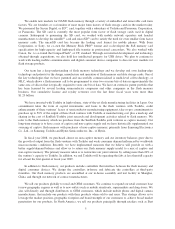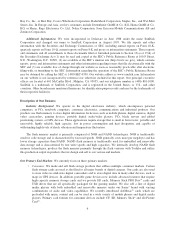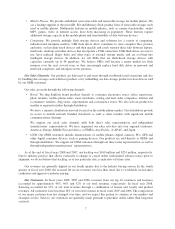SanDisk 2008 Annual Report Download - page 18
Download and view the complete annual report
Please find page 18 of the 2008 SanDisk annual report below. You can navigate through the pages in the report by either clicking on the pages listed below, or by using the keyword search tool below to find specific information within the annual report.characterized by supply exceeding demand, which has led to significant declines in average selling prices. For
example, our average selling price per gigabyte for product revenues declined 70% in the fourth quarter of fiscal
year 2008 as compared to the same period of fiscal year 2007, and declined 62% in fiscal year 2008 compared to
fiscal year 2007. The price decline was especially aggressive in the second half of fiscal year 2008, with
sequential price declines of 30% in the third quarter and 28% in the fourth quarter. Price declines have exceeded
cost declines in each of the last three fiscal years, resulting in negative product gross margin in fiscal year 2008.
Price declines may be influenced by, among other factors, supply exceeding demand, macroeconomic factors,
technology transitions, conversion of industry DRAM capacity to NAND and new technologies or other strategic
actions by us or our competitors to gain market share. If our technology transitions take longer or are more costly
than anticipated to complete, or our cost reductions continue to fail to keep pace with the rate of price declines,
our product gross margin and operating results will continue to be negatively impacted, leading to quarterly or
annual net losses.
Over our history, price decreases have generally been more than offset by increased unit demand and
demand for products with increased storage capacity. However, in fiscal year 2008, price declines outpaced unit
and megabyte growth resulting in reduced revenue as compared to fiscal year 2007. There can be no assurance
that current and future price reductions will result in sufficient demand for increased product capacity or unit
sales, which could continue to harm our margins and revenue.
We have incurred negative product gross margins and net losses, which may continue to reduce our cash
flows and harm our financial condition. In the fourth quarter of fiscal year 2008, we had negative product gross
margins due to sustained aggressive industry price declines as well as higher inventory charges primarily due to
lower of cost or market write downs. We expect product gross margins to continue to be negative through the
first quarter of fiscal year 2009. Our ability to return to or sustain profitability on a quarterly or annual basis in
the future depends in part on industry and our supply/demand balance, our ability to develop new products and
technologies, the rate of growth of our target markets, the competitive position of our products, the continued
acceptance of our products by our customers, and our ability to manage expenses. If we fail to return to
profitability, continued operating losses will reduce our cash flows and cash resources, and negatively harm our
business and financial condition. If we are unable to generate sufficient cash, we may have to reduce, curtail or
terminate certain business activities.
Sales to a small number of customers represent a significant portion of our revenues, and if we were to lose
one of our major licensees or customers or experience any material reduction in orders from any of our
customers, our revenues and operating results would suffer. In fiscal years 2008, 2007 and 2006, revenues from
our top 10 customers and licensees accounted for approximately 48%, 46% and 52% of our total revenues,
respectively. In fiscal year 2008, Samsung accounted for 13% of our total revenues through a combination of
license and royalty and product revenues. All customers were less than 10% of our total revenues in fiscal years
2007 and 2006. The composition of our major customer base has changed over time, and we expect this pattern
to continue as our markets and strategies evolve. Sales to our customers are generally made pursuant to purchase
orders rather than long-term contracts. The composition of our major customer base has changed over time, and
we expect this pattern to continue as our markets and strategies evolve. If we were to lose one of our major
customers or licensees, or experience any material reduction in orders from any of our customers or in sales of
licensed products by our licensees, our revenues and operating results would suffer. Additionally, our license and
royalty revenues may decline significantly in the future as our existing license agreements and key patents expire
or if licensees fail to perform on a portion or all of their contractual obligations. Our sales are generally made
from standard purchase orders rather than long-term contracts. Accordingly, our customers may generally
terminate or reduce their purchases from us at any time without notice or penalty. In addition, the composition of
our major customer base changes from year-to-year as we enter new markets, making our revenues from these
major customers less predictable from year-to-year.
Our business depends significantly upon sales through retailers and distributors, and if our retailers and
distributors are not successful, we could experience reduced sales, substantial product returns or increased price
14
























